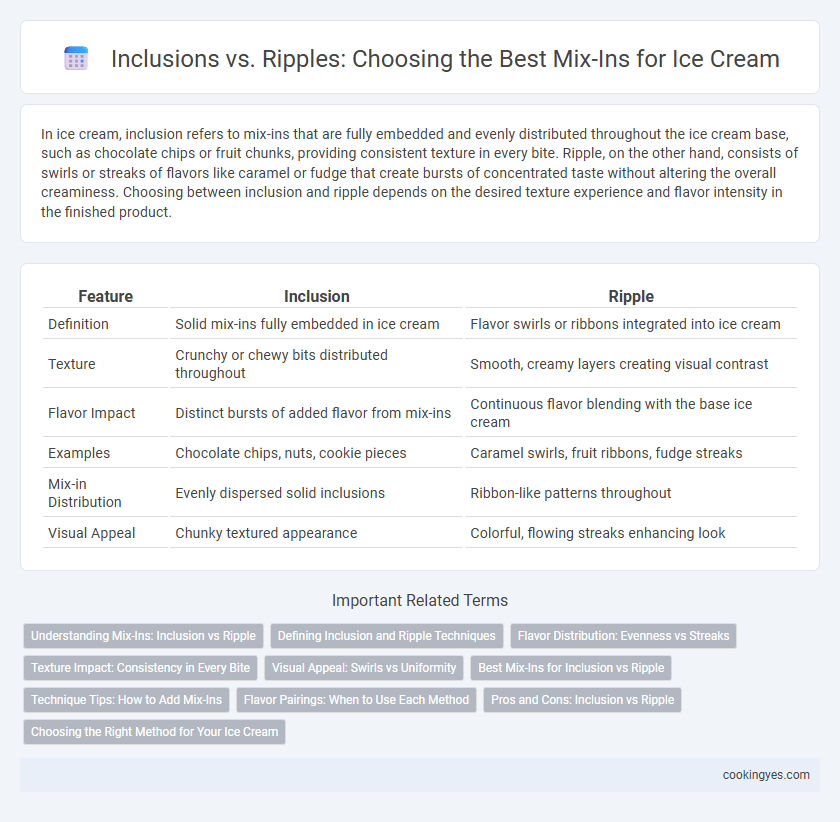In ice cream, inclusion refers to mix-ins that are fully embedded and evenly distributed throughout the ice cream base, such as chocolate chips or fruit chunks, providing consistent texture in every bite. Ripple, on the other hand, consists of swirls or streaks of flavors like caramel or fudge that create bursts of concentrated taste without altering the overall creaminess. Choosing between inclusion and ripple depends on the desired texture experience and flavor intensity in the finished product.
Table of Comparison
| Feature | Inclusion | Ripple |
|---|---|---|
| Definition | Solid mix-ins fully embedded in ice cream | Flavor swirls or ribbons integrated into ice cream |
| Texture | Crunchy or chewy bits distributed throughout | Smooth, creamy layers creating visual contrast |
| Flavor Impact | Distinct bursts of added flavor from mix-ins | Continuous flavor blending with the base ice cream |
| Examples | Chocolate chips, nuts, cookie pieces | Caramel swirls, fruit ribbons, fudge streaks |
| Mix-in Distribution | Evenly dispersed solid inclusions | Ribbon-like patterns throughout |
| Visual Appeal | Chunky textured appearance | Colorful, flowing streaks enhancing look |
Understanding Mix-Ins: Inclusion vs Ripple
Inclusion mix-ins integrate ingredients directly into the ice cream base, creating a uniform texture and consistent flavor throughout each bite. Ripple mix-ins consist of swirls or ribbons of sauces or fruit, providing distinct pockets of concentrated taste that contrast with the creamy base. Choosing between inclusion and ripple affects the overall sensory experience, balancing texture, flavor distribution, and visual appeal in the final product.
Defining Inclusion and Ripple Techniques
Inclusion techniques involve embedding mix-ins such as nuts or fruit pieces directly into the ice cream base during the freezing process, creating a uniform distribution throughout the product. Ripple techniques introduce swirls of flavored syrup or sauce, like chocolate or caramel, added after the ice cream is partially frozen to preserve distinct layers and visual appeal. Both methods enhance flavor and texture, but inclusions offer consistent bites while ripples provide contrasting bursts of taste.
Flavor Distribution: Evenness vs Streaks
In ice cream mix-ins, inclusions offer a consistent flavor distribution by evenly dispersing ingredients like fruit bits or cookie pieces throughout the base. Ripple mix-ins create distinct streaks of intense flavor, such as swirls of caramel or fudge, providing bursts of concentrated taste in each bite. Choosing between inclusions and ripples depends on whether a smooth, uniform flavor or a bold, textured contrast is desired.
Texture Impact: Consistency in Every Bite
Inclusion mix-ins create a uniform texture by dispersing small, evenly sized pieces throughout the ice cream, ensuring consistent crunch and flavor in every bite. Ripple mix-ins introduce a swirled contrast of smooth and textured elements, providing varied mouthfeel but less uniformity across scoops. The choice between inclusion and ripple directly influences the ice cream's overall texture consistency and consumer satisfaction.
Visual Appeal: Swirls vs Uniformity
In ice cream, inclusion mix-ins create a uniform texture by evenly dispersing chunks throughout the scoop, offering consistent flavor in every bite. Ripple mix-ins produce visible swirls of sauce or syrup, enhancing visual appeal with contrasting colors and patterns that catch the eye. The choice between inclusion and ripple depends on the desired aesthetic and texture experience in the final product.
Best Mix-Ins for Inclusion vs Ripple
Best mix-ins for inclusion in ice cream ensure even distribution of ingredients like cookie dough chunks or nuts throughout the entire batch, enhancing consistent flavor and texture in every bite. Ripple mix-ins, such as fruit swirls or caramel ribbons, create distinct layers or pockets of flavor that provide a contrasting taste experience within the ice cream. Choosing between inclusion and ripple depends on whether a uniform blend or a variegated texture is desired for the final product.
Technique Tips: How to Add Mix-Ins
Inclusion mix-ins involve folding ingredients like nuts, chocolate chips, or fruit pieces directly into the ice cream base before freezing to ensure even distribution throughout. Ripple mix-ins require swirling sauces such as caramel, fudge, or fruit purees into semi-frozen ice cream, creating visually appealing ribbons and bursts of concentrated flavor. Achieving the perfect texture for inclusions means controlling the size and moisture content of the mix-ins, while ripples demand precise timing and gentle folding to avoid blending completely into the base.
Flavor Pairings: When to Use Each Method
Inclusion mix-ins, like nuts or chocolate chips, are ideal for evenly distributed texture and consistent flavor in each bite, enhancing creaminess without overpowering the base ice cream. Ripple mix-ins, such as fruit swirls or caramel ribbons, create vibrant flavor contrasts and visually dynamic patterns, best used when highlighting complementary or tangy flavors that stand out against the creamy background. Choosing between inclusion and ripple depends on the desired taste experience: inclusion for subtle, integrated flavor pairings and ripple for bold, segmented bursts of flavor.
Pros and Cons: Inclusion vs Ripple
Inclusion mix-ins are solid pieces fully blended into ice cream, offering consistent texture and bursts of flavor throughout each bite but can sometimes lead to uneven distribution and potential hardness. Ripple mix-ins consist of swirled sauces or syrups, providing smooth flavor contrast and visually appealing patterns while maintaining a softer texture, though they may dilute the overall ice cream creaminess. Choosing between inclusions and ripples depends on desired mouthfeel, flavor intensity, and presentation.
Choosing the Right Method for Your Ice Cream
Choosing between inclusion and ripple methods for mix-ins depends on the desired texture and flavor distribution in your ice cream. Inclusions, such as nuts or cookie pieces, provide distinct bursts of texture evenly throughout the ice cream, while ripples, like fudge or fruit syrups, create swirls that offer concentrated flavor pockets. Consider the balance between crunchy elements and smooth flavor trails to enhance the overall sensory experience in each scoop.
Inclusion vs Ripple for mix-ins Infographic

 cookingyes.com
cookingyes.com